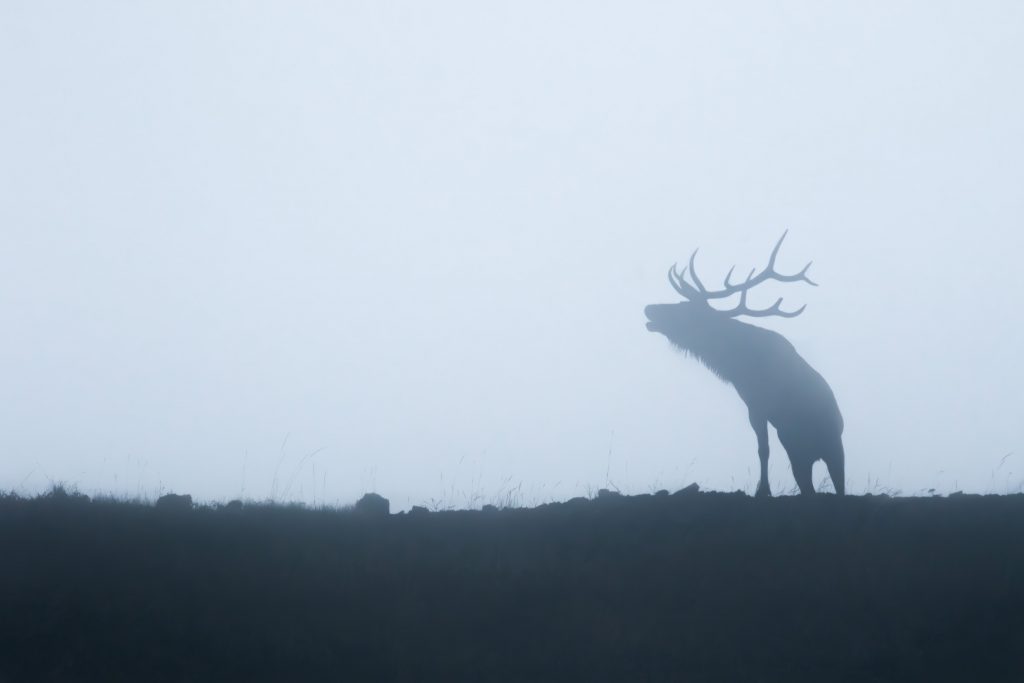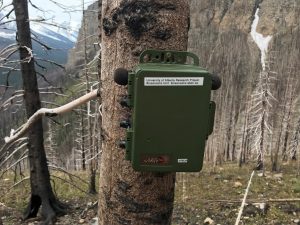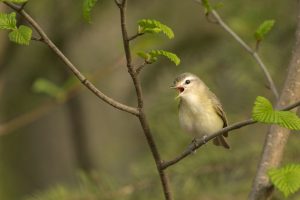Out of Sight: How Scientists are Listening in on Nature in Alberta

BY RICHARD HEDLEY
Imagine you are a field biologist. You’ve been hired to conduct surveys to monitor bird populations in Alberta’s boreal forest. Here are your instructions:
Drive north from Fort McMurray for exactly 95.0 kilometres and find a place to park beside the road. Put on your hiking boots (you’re going to need them) and tromp northwest through the thick underbrush until you reach the shores of the Athabasca River. Inflate your pack raft (you brought one, didn’t you?) and paddle to the other side. Then, follow your compass at a precise bearing of 321.6 degrees. Your destination is 64 kilometres away, but hey, the data won’t collect itself. Trudge through the knee-deep fens, bushwhack through thorny undergrowth, skirt the lakes… Just keep going, you’ve got work to do. Given the distance, reaching your destination on foot may very well take several days, but in the absence of roads and trails, walking is really the only option. Oh, and try not to be late — you need to arrive at dawn, since that’s when the birds will be singing.
Once you arrive at your destination, your instructions are to count the birds around the survey point for three minutes. In other words, you are to conduct a “point count,” which is the standard method for documenting breeding bird communities.
After you’ve completed the three-minute count, your work is done. Start the trek back to your vehicle and take a few days off. You’ve earned it.
Passive Acoustic Monitoring: The Way of the Future
If the scenario described above seems impossibly inefficient, that’s because it is. Simply put, sending biologists dozens of kilometres into roadless wilderness to conduct one or two short surveys is seldom practical. However, despite their inherent challenges, biodiversity surveys in remote areas are immensely valuable. One of the central goals of conservation biology is to accurately document and understand changes in biodiversity over time, and while this does not necessarily require surveys to be carried out everywhere, monitored locations should be representative of the broader landscape. In an ideal world, that means conducting surveys in remote areas and populated areas alike. Given these considerations, is there any way to efficiently collect accurate, high-quality information on wildlife in remote areas, without the need for Herculean efforts on the part of field workers?
One solution that is being rolled out at an accelerating pace is passive acoustic monitoring. Boiled down to its essence, passive acoustic monitoring is very simple: it involves little more than placing a sound recording device out in nature and allowing it to record. Left unattended, the microphones pick up bird songs, frog choruses, owl hoots, wolf howls, and any other audible sound. After a period of time — anywhere from a few days to several months — the recording unit can be retrieved, the data downloaded to a computer, and the recordings analyzed.
To best illustrate the power of this approach, imagine you are a biologist once again. As before, you’ve been hired to conduct surveys to monitor bird populations in Alberta’s boreal forest. Here are your instructions:
Wake up in the morning, at a time that suits your fancy. Roll out of bed, put your slippers on, and prepare a pot of coffee. Shuffle to your computer, put on some headphones, open up a sound recording, and start listening. Once again, your instructions are to count birds for three minutes, only this time you will be counting them exclusively by ear. After completing the three-minute count, your work is done. Have a sip of coffee and move on to the next recording.
For interest’s sake, I carried out a three-minute count at the location described in the opening paragraphs of this article. My chosen time for surveys was 5:44 a.m. on May 30, 2018, which coincides with the early breeding season for most northern Albertan bird species. The location lies dozens of kilometres from the nearest road; accessing it by foot is, as emphasized earlier, effectively impossible. Yet, even though I never left the comfort of my desk, I can confidently assert the following: had you stood at this location at that time, on that particular morning, the first bird you would have detected was a Canada goose flapping and honking in a nearby body of water. Exactly 3.5 seconds later, your ears would have been treated to the flute-like song of a hermit thrush in the distance, followed two seconds later by the “tinkle-buzz-click” of a savannah sparrow. Over the next three minutes, you would have accumulated a list of 16 individuals of 13 bird species.

Figure 4: An example of a spectrogram. Spectrograms allow sounds to be visualized in terms of frequency and time. Darker colors indicate more sound energy at a given frequency at a moment in time. Different species and types of sounds have different characteristic patterns, which can help with species identification. The sound depicted here is the first eight seconds of the sound described in the article. Box 1: A Canada goose flapping in the water appears as chaotic noise across a wide range of frequencies. 2: The same Canada goose’s honks appear at lower frequencies. 3: The song of a hermit thrush in the distance appears as horizontal lines. 4: This savannah sparrow sang its high-frequency song from near the microphone, hence its clarity.
Clearly, from the perspective of the biologist conducting surveys, acoustic monitoring is a boon. Travel time is reduced to the time it takes to move from bed to desk. Bug bites and bear scares are eliminated altogether. When scaled up, a single, skilled ornithologist can survey hundreds or even thousands of locations each year across geographic regions of arbitrary size, and can do so at any time of year. In addition to allowing greater flexibility, the surveyor can work at their own pace, rewinding and replaying difficult sounds as needed, and also benefits from the visual aid of a spectrogram.
Readers may at this point be wondering, what about the birds that don’t sing? To be sure, acoustic monitoring leaves the surveyor blind to their surroundings, which makes it more effective for some species than others. Ducks provide a familiar example of a group for which acoustic monitoring is not ideal. Sure, the quacks of different duck species can be distinguished by a trained ear, but the fact that ducks often congregate in large groups is a problem. The sound of a quack might reveal the presence of mallards, but whether there is a single mallard, ten mallards, or a flock of 50 lurking quietly nearby may be unknowable by sound alone.
Acoustic monitoring is thus best applied to species that vocalize frequently. Fortunately, vocal prodigiousness is a feature of most songbirds as well as many non-songbirds. To quantify the relative importance of visual versus auditory cues on bird surveys, researchers sent three experienced surveyors to conduct point counts side-by-side in the woodlands of North Carolina.1 One observer conducted surveys blindfolded, a second observer was artificially deafened with headphones playing white noise, and a third was allowed the use of their full sensory abilities. The blinded observer detected 96% as many birds as the unconstrained observer, whereas the deafened observer detected just 3% of the total. These results show that, when it comes to bird surveys, the ear is mightier than the eye, and it’s not even close.

An autonomous sound recording unit deployed in nature. Photo by César Estevo
The major drawback of acoustic monitoring — its lack of visual cues — is therefore hardly a drawback at all. On the other hand, the advantages of acoustic monitoring are substantial. First of all, the fact that trained observers need not be present in the field is worth re-emphasizing. To be sure, someone has to deploy each recording unit. However, in the remote parts of Canada, site access is often easier in the winter than in the summer. Lakes and rivers are frozen, spongy bogs are solid, and winter roads are open. With acoustic monitoring, recording units can be deployed one winter and retrieved the next. The flexibility of modern recording units allows their recording schedules to be tailored to the behavioural characteristics of each species group. Thus, a single deployment effort can record the peak activity of owls (April), frogs (May), songbirds (late May to July), and ungulates (fall). Moreover, recording units can be deployed by anyone, whether they are experienced biologists or not. Where traditional survey programs consistently struggle to find experts who can accurately conduct biodiversity surveys, passive acoustic monitoring allows fewer skilled observers to carry out a larger number of surveys from afar, aided by a field workforce with a different skill set.
Acoustic Monitoring in Alberta
Albertans may be surprised to discover that this province is undeniably a global hotspot — perhaps the global hotspot — for passive acoustic monitoring. The bulk of the effort has been spearheaded by the Alberta Biodiversity Monitoring Institute (ABMI) in partnership with the Bioacoustic Unit at the University of Alberta, led by Erin Bayne. Spurred by the recent availability of commercial recording units, cheap data storage, and efficiency gains brought about by the decreased reliance on expert surveyors, the acoustic monitoring program has expanded quickly. Collaborations have further accelerated growth: botanists, mammologists, hydrologists, and citizen scientists are being tapped to deploy recording units wherever their regular activities take them, which has allowed recordings to pour in from across the province.
Already, the passive acoustic monitoring data set that resides at the University of Alberta is enormous. Listening to all recordings continuously, with no breaks for eating, sleeping or anything else, would take about 200 years. These recordings originate from more than 10,000 locations across every part of the province. This concerted effort to record nature has resulted in one of the richest and most comprehensive biological data sets ever collected.
The recording program has two components. The first is a systematic effort that piggybacks on ABMI’s broad biodiversity monitoring program involving 1,656 fixed monitoring locations laid out in a 20-km grid across the entire province. In addition to acoustic monitoring, this program employs camera traps for detecting mammals and active data collection by monitoring teams during site visits.
ABMI’s systematic monitoring program is designed to provide a representative ecological picture of the entire province. The program is well-suited to detecting broad-scale changes affecting the most common species and ecosystem types. For example, the information being collected now will allow scientists to track the effects of climate change on Alberta’s biodiversity.
However, with just 1,656 locations spread across the entire province, rare species and rare types of ecosystems can easily be missed. Therefore, the acoustic monitoring program has a second component that involves targeted sampling to fill in gaps. Targeted sampling aims to answer specific questions on an as-needed basis. For example, we might want to better characterize the status of an uncommon species, such as yellow rails. Or we might want to determine how specific industrial practices are affecting bird populations.
Regardless of the question being asked, the methods used are identical: deploy a recording unit and let it record. Most importantly, these recordings all end up in the same repository, a massive digital data bank that continues to grow at an accelerating pace.
Biodiversity Snapshots for the Future

A singing warbling vireo (Vireo gilvus) by Nick Parayko.
Biodiversity monitoring helps scientists address both “known unknowns” and “unknown unknowns.”2 Known unknowns are those conservation issues that have already been identified. We know, for example, that rusty blackbirds have declined to roughly 10% of their former abundance, but we don’t know exactly why. Research focused on determining the cause of the decline entails the study of a known unknown.
Unknown unknowns are those conservation issues that we are not aware of until they smack us in the face. An example is chytridiomycosis, a fungal disease arising in the 1990s that has decimated frog populations in many parts of the world. Multiple researchers noticed population declines at their respective study sites, but only after conversing with colleagues did they realize there was a common cause that had already gone global.
Monitoring for unknown unknowns is challenging to justify because the purpose is not defined in advance. Nevertheless, it can pay large dividends. Again, the chytridiomycosis example is illustrative. Once the fungal pathogen had been identified, researchers were able to trace its geographical origins and historical spread in great detail using museum specimens. This was only possible because museum workers around the world had regularly collected specimens—not necessarily to answer any particular question, but because they recognized that such collections might someday prove valuable for answering emerging questions of fundamental importance to conservation.
Herein lies the greatest strength of acoustic monitoring: it fulfills the dual purpose of simultaneously addressing known unknowns and unknown unknowns. In the case of ABMI’s massive data set, recordings collected for one purpose inevitably contain “by-catch” that makes them relevant for other uses. For example, recording units placed in wetlands to listen for yellow rails also record myriad other species of birds, mammals, frogs, and insects, as well as human-generated noises such as car traffic and machinery. Although these ancillary sounds may be ignored in the initial project, they remain available for further study at a future date.
As just one example of how such data sets can be leveraged, I am currently working on a project using recordings from over 3,000 locations in Alberta to map the distribution of human-generated noise. Visiting these locations to collect data myself would require many years of effort and hundreds of hours of driving. But without leaving home, I have been able to peruse the acoustic database to document the patterns of human-generated noise across the entire province. The data clearly show that locations near roads are noisier than locations far from roads, and locations in remote wilderness are only exposed to the occasional airplane flyover — no surprises there. But this project will allow an estimate, for the first time, of how much noise there is and where in the province it occurs. All this from recordings made for entirely different purposes.
What exciting insights might emerge from Alberta’s extensive passive acoustic monitoring programs in the future? The potential is vast, though full realization of this potential will hinge upon the extent to which computers can learn to identify sound sources using pattern recognition techniques. This is because the growth of the acoustic database is quickly exceeding our ability to process it manually. Ultimately, nobody can predict what will come of it — that’s why we call them unknown unknowns. The good news is, if new threats emerge that jeopardize Alberta’s biodiversity, we’ll be listening.
Interested readers can visit the Bioacoustic Unit’s webpage at bioacoustic.abmi.ca to learn more. Acoustic data processing was carried out using ABMI’s online data processing platform called Wildtrax, available at wildtrax.ca.
References
- Brewster, J. P. and T.R. Simons (2009). Testing the importance of auditory detections in avian point counts. Journal of Field Ornithology, 80(2), pp. 178–182. doi: 10.1111/j.1557-9263.2009.00220.x.
- Wintle, B. A., M.C. Runge and S.A. Bekessy (2010). Allocating monitoring effort in the face of unknown unknowns. Ecology Letters, 13(11), pp. 1325–1337. doi: 10.1111/j.1461-0248.2010.01514.x.
Richard Hedley is a postdoctoral researcher at the University of Alberta. His work explores the use of sound recordings as a tool for monitoring populations of wildlife.
This article originally ran in Nature Alberta Magazine - Summer 2021
